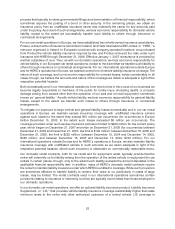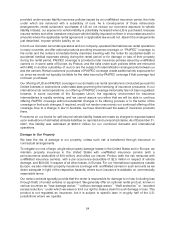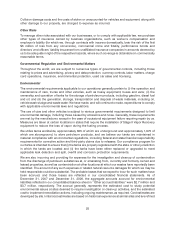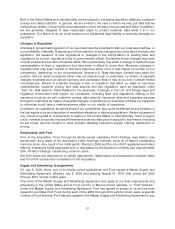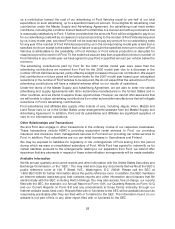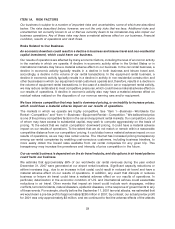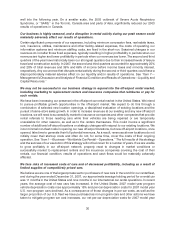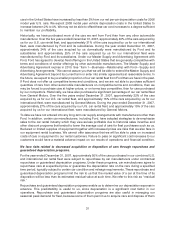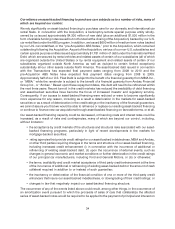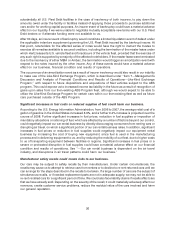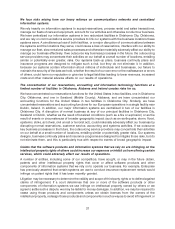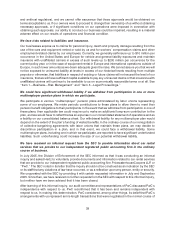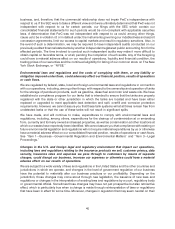Hertz 2007 Annual Report Download - page 52
Download and view the complete annual report
Please find page 52 of the 2007 Hertz annual report below. You can navigate through the pages in the report by either clicking on the pages listed below, or by using the keyword search tool below to find specific information within the annual report.after relatively short periods of time. A trade-off we face when we purchase program cars is that we
typically pay the manufacturer of a program car more than we would pay to buy the same car as a
non-program car. Program cars thus involve a larger initial investment than their risk counterparts. If a
program car is damaged or otherwise becomes ineligible for return or sale under the relevant program,
our loss upon the disposition of the car will be larger than if the car had been a non-program car,
because our initial investment in the car was larger.
The percentage of our car rental fleet subject to repurchase or guaranteed depreciation programs has
substantially decreased due primarily to changes in the overall terms offered by automobile
manufacturers under repurchase programs. Accordingly, we are now bearing increased risk relating to
the residual market value and the related depreciation on our car rental fleet and must use different
rotational techniques to accommodate our seasonal peak demand for cars.
Repurchase and guaranteed depreciation programs generally provide us with flexibility to reduce the
size of our fleet by returning cars sooner than originally expected without risk of loss in the event of an
economic downturn or to respond to changes in rental demand. This flexibility has been reduced as the
percentage of program cars in our car rental fleet has decreased materially. See ‘‘Item 1—Business—
Worldwide Car Rental—Fleet’’ and ‘‘Item 7—Management’s Discussion and Analysis of Financial
Condition and Results of Operations—Overview.’’
In the future, car manufacturers could modify or eliminate their repurchase or guaranteed depreciation
programs or change their return policies (which include condition, mileage and holding period
requirements for returned cars) from one program year to another to make it disadvantageous to acquire
certain cars. Any such modification or elimination would increase our exposure to the risks described in
the preceding paragraphs. In addition, because we obtain a substantial portion of our financing in
reliance on repurchase and guaranteed depreciation programs, the modification or elimination of those
programs, or the associated return policies, by manufacturers or significant adverse changes in the
financial condition of manufacturers could make some vehicle-related debt financing more difficult to
obtain on reasonable terms. See ‘‘—Our reliance on asset-backed financing to purchase cars subjects
us to a number of risks, many of which are beyond our control.’’
We could be harmed by a decline in the results of operations or financial condition of the
manufacturers of our cars, particularly if they are unable, or reject their obligations, to repurchase
program cars from us or to guarantee the depreciation of program cars.
In the past several years, Ford and General Motors, which are the principal suppliers of cars to us on
both a program and non-program basis, have experienced deterioration in their operating results and
significant declines in their credit ratings. A severe or persistent decline in the results of operations or
financial condition of a manufacturer of cars that we own could reduce the cars’ residual values,
particularly to the extent that the manufacturer unexpectedly announced the eventual elimination of its
models or nameplates or ceased manufacturing them altogether. Such a reduction could cause us to
sustain a loss on the ultimate sale of non-program cars, on which we bear the risk of such declines in
residual value, or require us to depreciate those cars on a more rapid basis while we own them.
In addition, if a decline in results or conditions were so severe as to cause a manufacturer to default on
an obligation to repurchase or guarantee the depreciation of program cars we own, or to cause a
manufacturer to commence bankruptcy reorganization proceedings, and reject its repurchase or
guaranteed depreciation obligations, we would have to dispose of those program cars without the
benefits of the associated programs. This could significantly increase our expenses. In addition,
disposing of program cars following a manufacturer default or rejection of the program in bankruptcy
could result in losses similar to those associated with the disposition of cars that have become ineligible
for return or sale under the applicable program. Such losses could be material if a large number of
program cars were affected. For example, we estimate that if Ford Motor Company, but not its
subsidiaries, were to file for bankruptcy reorganization and reject all its commitments to repurchase
32



